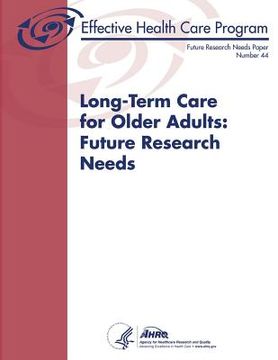Compartir
Long-Term Care for Older Adults: Future Research Needs: Future Research Needs Paper Number 44 (en Inglés)
U. S. Department of Heal Human Services
(Autor)
·
Agency for Healthcare Resea And Quality
(Autor)
·
Createspace Independent Publishing Platform
· Tapa Blanda
Long-Term Care for Older Adults: Future Research Needs: Future Research Needs Paper Number 44 (en Inglés) - And Quality, Agency for Healthcare Resea ; Human Services, U. S. Department of Heal
$ 23.390
$ 38.990
Ahorras: $ 15.600
Elige la lista en la que quieres agregar tu producto o crea una nueva lista
✓ Producto agregado correctamente a la lista de deseos.
Ir a Mis Listas
Origen: Estados Unidos
(Costos de importación incluídos en el precio)
Se enviará desde nuestra bodega entre el
Lunes 12 de Agosto y el
Lunes 19 de Agosto.
Lo recibirás en cualquier lugar de Chile entre 1 y 3 días hábiles luego del envío.
Reseña del libro "Long-Term Care for Older Adults: Future Research Needs: Future Research Needs Paper Number 44 (en Inglés)"
This future research needs (FRN) report is a follow-up to the 2012 comparative effectiveness review (CER) "Long-Term Care for Older Adults: A Review of Home and Community-Based Services Versus Institutional Care." The review was intended to support policy and research decisionmaking. FRN projects identify gaps in the current research that limit the conclusions in CERs and inform researchers and research funders about these gaps. They aim to encourage research likely to fill the gaps and make the body of evidence more useful to decisionmakers. The CER addressed the following two Key Questions targeting direct comparisons of long-term care (LTC) provided through home and community-based services (HCBS) and in nursing homes (NHs) to older adults aged 60 and older: Key Question 1: What are the benefits and harms of LTC provided through HCBS compared with institutions such as NHs for older adults, aged 60 and older, who need LTC? a. To what extent do HCBS and NHs serve similar populations? b. How do the outcomes of the services differ when tested on similar populations? c. What are the harms to older adults as a result of HCBS and NHs? Key Question 2: What are the costs (at the societal and personal levels) of HCBS and NHs (per recipient and in the aggregate) for adults age 60 and older? Costs may include direct costs of care as well as resource use and family burden. Direct costs of care refer to public program and individual spending on LTC services for HCBS recipients and NH residents. Resource use includes program and individual spending on acute care services such as physician and hospital care as well as spending by other subsidy or transfer programs. Family burden includes the opportunity costs of care. LTC refers to a broad range of services designed to provide assistance over prolonged periods to compensate for loss of function due to chronic illness or physical or mental disability. LTC includes hands-on, direct care as well as general supervisory assistance. HCBS refers to services provided in an array of non-institutional settings. These include recipients' homes; community-based group-living arrangements such as congregate housing, adult foster care, and residential care and assisted living (AL) facilities (the last two terms are sometimes used interchangeably, but we refer to AL exclusively); and community settings such as adult day care and adult day health. NHs are state-licensed institutional facilities offering 24-hour room and board, supervision, and nursing care. Results from relevant observational studies were qualitatively synthesized; no relevant randomized controlled trials (RCTs) were identified. The authors found that on average, NH residents had more limitations in physical and cognitive function than both HCBS recipients and AL residents, but mental health and clinical status were mixed. The studies that compared the outcome trajectories of HCBS recipients or AL residents with NH residents over time had high risk of bias, resulting in low or insufficient evidence for all outcomes examined. In comparing AL with NH, low-strength evidence suggested no differences in outcomes for physical function, cognition, mental health, and mortality. In comparing HCBS with NHs, low-strength evidence suggested that HCBS recipients experienced higher rates of some harms while NH residents experienced higher rates of other harms. Evidence was insufficient for other outcome domains and comparisons. Evidence was also insufficient for cost comparisons. Overall, the CER concluded that it is difficult to determine whether and how the delivery of LTC through HCBS versus NHs affects outcome trajectories of older adults due to scant evidence and the methodological limitations of studies reviewed. The authors concluded that more and better research is needed to draw robust conclusions about how care settings influence outcomes and costs of LTC for older adults.
- 0% (0)
- 0% (0)
- 0% (0)
- 0% (0)
- 0% (0)
Todos los libros de nuestro catálogo son Originales.
El libro está escrito en Inglés.
La encuadernación de esta edición es Tapa Blanda.
✓ Producto agregado correctamente al carro, Ir a Pagar.

